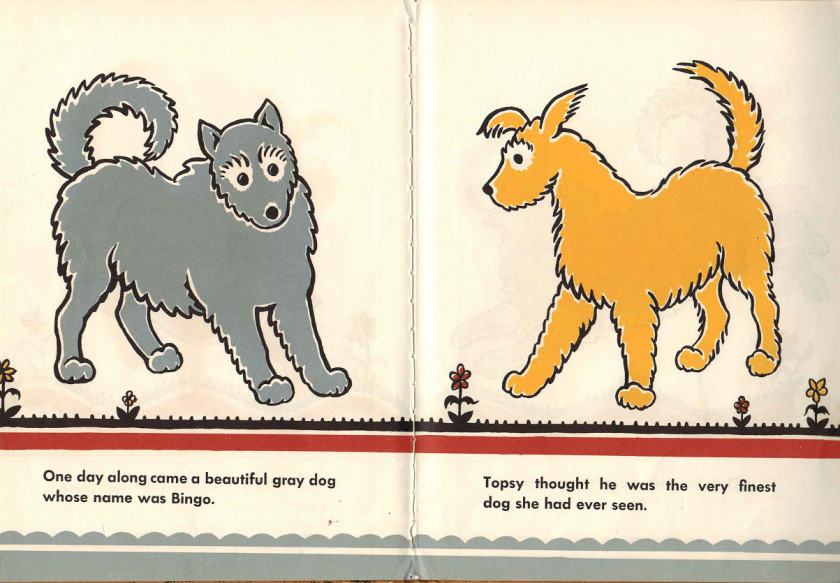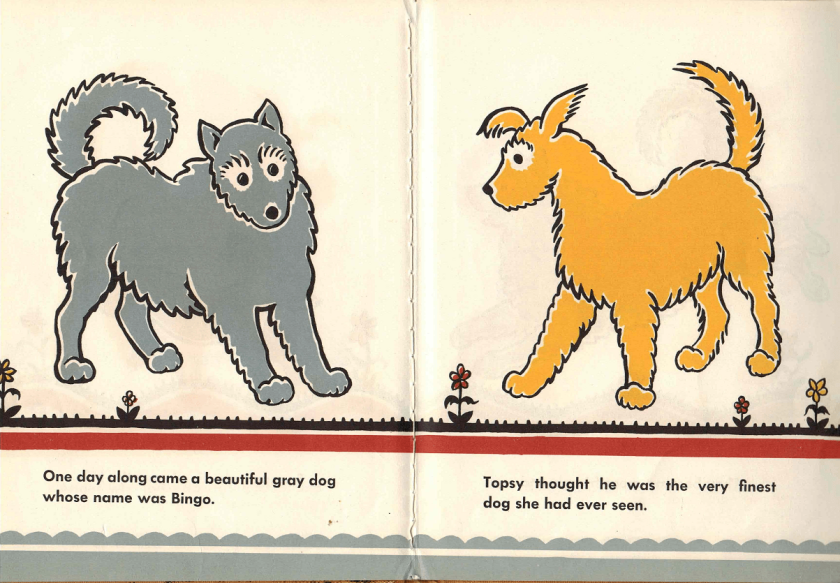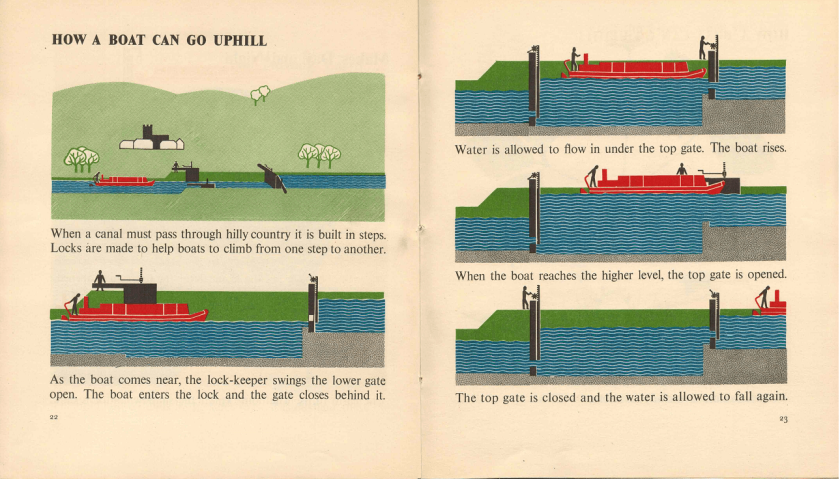My vintage-book collection expanded this summer with two picture books published within two years of each other. One is fiction, the other nonfiction, and both have beautifully rendered color illustrations from a time before color separation was the norm. Both also contain content that wouldn’t raise an eyebrow in the late 1940s, but might keep them from being published today.
 TOPSY
TOPSY
story and pictures by Hetty Burlingame Beatty
1947 Houghton Mifflin Company, The Riverside Press, Cambridge, MA
20 pages (surprisingly, not 32 pages!)
TOPSY is a simple story about a girl dog and her animal friends.
Not much happens plot-wise until the center spread, when Topsy meets Bingo, a boy dog who is “the very finest dog she had ever seen.” They gallop off into the hills together.
Has one of your friends ever “gone missing” after starting a new romantic relationship? That happens to Topsy’s friends, so they go looking for her. The last page shows what they discover.
In 1947, when TOPSY was published, the arrival of a litter of kittens or puppies was a prime opportunity to discuss the “facts of life” with children. A book featuring a litter of puppies conceived by unneutered, free-range pets, wouldn’t raise an eyebrow. Today, the irresponsible behavior of Topsy’s owners would keep the manuscript from ever leaving the slush pile. (I also wonder about the offspring of Spitfire the cat and Old Red Hen—how is it that the kittens and chicks stay perpetually young, while Topsy grows up and has puppies?)
But set the plot aside and look at the amazing art! It’s the reason I bought the book. The originals would have been black and white, with instructions to the printer for placing each block of color. This book was printed with three inks: black, a red-brown, and a dark yellow. The book predates Pantone by fifteen years, so I don’t know how the ink colors were specified, but the overall effect is an impressive example of an artist using a particular process to good advantage.
 I’ll show you how it happens
I’ll show you how it happens
by Marie Neurath
1949 Chanticleer Press Inc., New York, NY, 32 pages
Printed by Jarrold & Sons LTD, Norwich, England, in Four-Color Offest-Litho
This science picture book does a great job explaining 14 topics, each in well-illustrated two-page spreads. My day job is writing and editing science educational materials for classroom use, so I was pleased to see the range of topics and the accuracy of both art and text. The examples below illustrate how two kinds of seeds scatter in the wind, and how canal locks are engineered to let boats travel uphill.
But the two-page spread that wouldn’t make it past today’s editorial boards is this one, about hot-air balloons.

If this were a commercially-produced hot-air balloon, it would be okay. But no: This is the kind of do-it-yourself paper-bag open-flame hot-air balloon that my husband and his brother floated out of their college dorm window one dull winter evening. (“Really! We were just doing a physics experiment!”) Clearly the two children in this picture book also chose winter for their balloon launch, because there are no leaves on the trees. Or maybe the leaves were burned off by previous experiments. Either way, it looks like these two picture-book kids survived their risky childhood, and went on to achieve lasting fame as the universal symbols for restrooms.
But joking aside, both of these are beautiful examples of picture books from a time when producing color illustrations meant working within limitations. I hope you enjoyed this quick look! Both Beatty and Neurath had careers outside of writing and illustrating children’s books. You can learn more about them at the links below.
More about the author/illustrators:
Hetty Burlingame Beatty (1907 – 1971) biography on Jane Badger Books
Marie Neurath (1898 – 1986) biography on Hyphen Press
Can you think of examples of children’s books that might not be published today? Any classics that are still in print, that make you wonder? Share them in the comments.











I used to have a book called The Littlest Rabbit by Robert Kraus. Big rabbits bully main character. His response? Eat, sleep, and pray. (Not telling adults.) Finally, main character is the biggest rabbit of all! He sees younger bunnies being beaten up by bigger ones as he had been, and beats up the bullies. Not thinking that would be published today.
LikeLike
This is fascinating! I ❤ vintage children's books. Surprisingly, Curious George is one of the most popular series at my library.
LikeLike
Thank you for this excellent article. There are some recent books that have limited color and the look of hand separations, but they are probably done with Illustrator on the computer. Do you know the work of Dahlov Ipcar? More complex, but still the charm of yesteryear and the bow to hand separation. http://www.islandportpress.com/dahlov-ipcar.html
LikeLike
Wow, that link to Dahlov Ipcar just pulled 20 minutes out of my day! Gorgeous artwork.
LikeLike
There are so many children’s books from years past that would never be published today. These are great examples. Thanks for the post.
LikeLiked by 1 person
How about Curious George? A classic, beloved story and series, for sure. But I just re-read it recently. Can you imagine the backlash if someone today published a book about a man in a yellow hat who captured a monkey, forced him on a boat, and then caged him in a zoo? He was definitely not “rescued” in the original story! Poor George:(
LikeLiked by 2 people
Thank you! I was hoping someone would bring that one up. The first time I read it as an adult, to my children, I was outraged. George’s journey is exactly that of people who were captured and enslaved from Western Africa, a few centuries back. And George is supposed to be happy and grateful? And he is an ape, not a monkey like they keep saying he is. I was disappointed when PBS chose to promote this story with a cartoon. I’m sure the tv show avoids these issues but it’s broadcast points toward the original stories.
LikeLike
The restroom symbol bit made me spit out my coffee!
Speaking of books that shouldn’t be reprinted today: in an antique shop with a friend we stumbled across a book about a bunny who wanted wings. My friend got all mushy about it, having fond memories of reading it as a child. Not having read it, I did so on the spot. And. . . wow. Bunny wants wings. Bunny gets wings. Bunny is then rejected by everyone who knows her, including her own mother. Bunny finally ditches the wings somehow and resumes her normal bunny life.
My take on the book’s moral: don’t get uppity. You are born to be a housewife and/or bunny and bad things will happen if you chase your dreams.
Oddly enough, this book is still in print. I would be curious to know the demographics of who is buying it.
LikeLiked by 1 person
THE LITTLE RABBIT WHO WANTED RED WINGS was a childhood staple for me too. Right up there with THE LITTLE ENGINE THAT COULD. So twisted — I agree.
LikeLiked by 1 person
Hmm… not a book I would have encouraged my girls to read. If bunny never got wings and learned to live and thrive with what she was able to get that’d be different. But to have everyone reject you when your dream comes true, and go back? I’m guessing this predates Jonathan Livingston Seagull.
Sorry about the spit coffee! No, not really. 😉
LikeLiked by 1 person
Marianne- these are total gems. I can not tell you how much I love that last spread in Topsy, and how hard it made me laugh. And the straightforward drawings/diagrams of the second book are so beautiful too. I always wonder: CAN you still get books printed that way? I really do love the feel of the more limited palettes and the way that illustrators end up stretching in other ways.
And I wonder too: where did you find the two books? I’m such a fan of digging around for old kids’ books at garage sales, thrift stores and the like.
Thanks for the post!
LikeLiked by 1 person
Hi Anna, glad you enjoyed it! I don’t know if you can even still produce art the old way, or if you’d just have to pretend you’re working under those limitations to get the same effect. It is impressive how creative artists get when working within such constraints. As for where the books came from, I found them at an antique mall somewhere north of Boston. My husband scours places like that for old binoculars, and I tag along and look for books. Usually I collect old science textbooks but sometimes I’ll pick up others too. Thanks for commenting!
LikeLike
Old binoculars?! Now I’m even MORE curious!
LikeLike